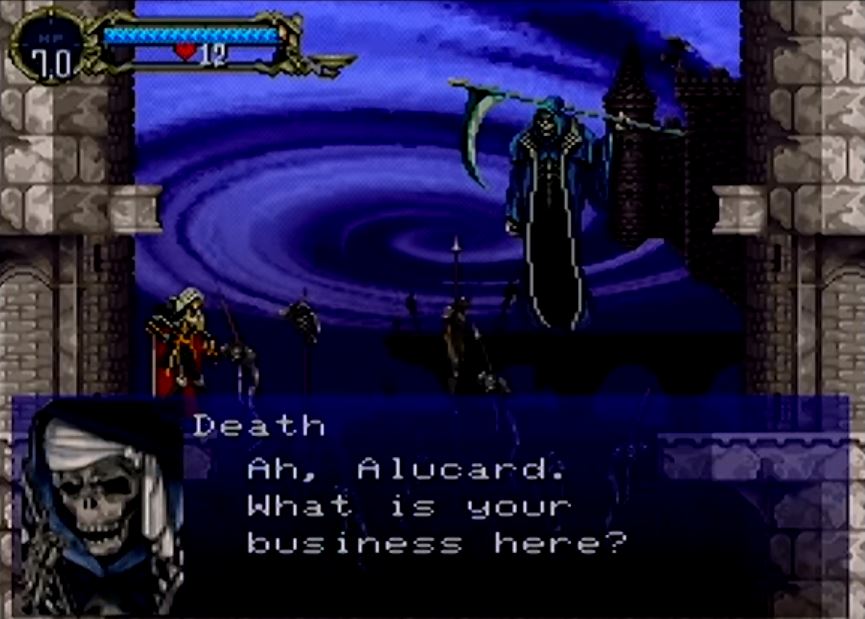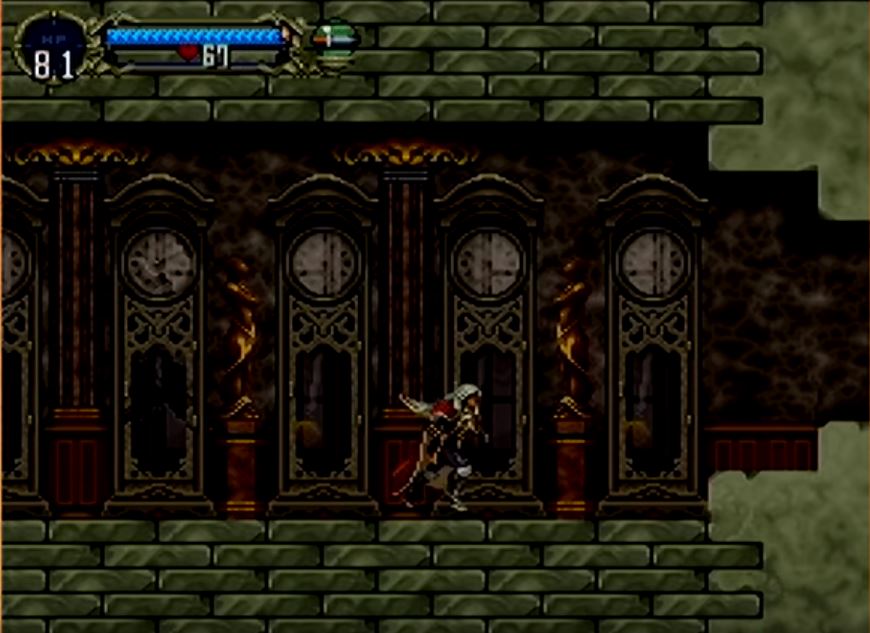PlayStation Top 10
After the announcement of the PlayStation Classic I decided to look back at my personal Top 10 PlayStation games to see if they hold up. Each gets a minimum of 3 hours of game play before I compare how I remember the game and how it plays now.
The rest of my Top 10 games are:
- Castlevania: Symphony of the Night
- Motoracer
- Grandia
- Crash Warped
- Resident Evil
- Quake 2
- Metal Gear Solid
- Final Fantasy VII
- Lunar: Silver Star Story Complete
- Lunar 2: Eternal Blue Complete
Symphony of the Night – Then (1997)
Mortal Kombat Mythologies: Sub-Zero was my first PlayStation game. I asked for and received it as a birthday present. Two days later, I realized what a terrible mistake I made and bought Castlevania: Symphony of the Night.
At the time of Castlevania’s release reviewers praised the game, but it was a 2D experience during the 3D revolution. It doesn’t have a place in the cultural zeitgeist like Final Fantasy VII or Tomb Raider. Despite the lack of mainstream recognition, among gamers its considered a classic. One of two inspirations for a whole genre called Metroidvania.
You may recognize the genre type from recent indie hits like Hollow Knight and Guacamelee. Less expensive to produce, but just as deep as games like Assassin’s Creed, Metroidvania’s style allows for creative world building on a budget. SOTN creator Koji Igarashi is even getting back into the game with spiritual successor to SOTN, Bloodstained.
I missed playing Super Metroid, so SOTN was my first experience with 2D open world exploration gameplay. The closest I’d come was Link to the Past on SNES. Both contain non-linear world to explore with new paths opening up as you find items and kill bosses, but SOTN approaches it from a side-scrolling perspective.

I explored Castle Dracula for hours on end. Scoured the internet for help, back when it was still on dial up. My original save, which I lost during the last decade, was 200% complete. Max completion is 200.6%, but I could never figure out how to get outside the castle to achieve that last big of map coverage. To this day, it’s the only game I’ve come close to fully completing.
Castlevania: Symphony of the Night has a special place in my personal gaming history. I’m not alone in my love for the game. Many top 10 lists of best PlayStation games has SOTN on it. Usually in the top 5. It’s exclusion from the PlayStation Classic is a disappointment, but makes sense considering its recent PS4 release.
It’s been roughly a decade since I last played Symphony of the Night. That play through wasn’t a completion run. I didn’t even bother with the inverted castled. For those who don’t know, there’s a whole hidden world to explore if you find the right item to defeat the “final” boss with.
Approaching the game now, I go in knowing I won’t reach the second half of the game. Three hours isn’t enough time to see it all, but it is enough time to know if memory matches current experience. How well does Castlevania: Symphony of the Night hold up? Let’s find out.
Symphony of the Night – Now (2018)
Symphony of the Night doesn’t have the typical problems shared by many PlayStation games simply by being a 2D game. Developers struggled in the early days of 3D. Controls and camera systems for 3D world were brand new problems to tackle. Developers experimented with a number of techniques, and like any experiment, most failed. It’s especially apparent how difficult that transition was now that many of those systems are standardized.
Castlevania builds on decades of 2D game development. The series itself was ten years old, and two console generations of experience shows in how polished SOTN is. The genre’s even more refined now, after dozens of titles worked out gameplay kinks, but it’s nothing compared to early 3D games from the PlayStation generation.

Controlling Alucard is fluid. His run is moderately paced, not too slow or fast. Enemies share the same deliberate approach to speed. This pacing allows player to control how they approach the game. If you prefer a more action based game, you can barrel through each area killing whatever crosses your path. It’s not Contra level run and gun speed, but its equal to any Mega Man game.
If you take it slow, you’ll have a different experience. Approaching enemies with caution reveals clear patterns to avoid, and allows you to equip more appropriate weapons. Watching a few Let’s Plays shows most players balance between the two styles, which is exactly how I played. Hacking and slashing through some areas and cautiously approaching others as a puzzle, especially the larger enemies. Play how you prefer, the game works for all gamer types.
The rest of the controls are tight and responsive. Attacking is deliberate and animated so every move is distinct. Different weapon types move at a different speed and distance, and how that works is clear on the screen. Timing and range are account for.
Jumping takes the same approach. The arc Alucard follows is a clear path, with the descent being faster than the rise. Jumping from higher ledges adds speed and weight to the landing. You’ll gain a double jump eventually, but it only adds to the tight controls. His jumping is so clear you never question whether he’ll make the jump or not. I tried anyway, but I knew it wasn’t going to work. Sometimes failing leads to hidden areas, so take a chance.
Taking a hit has the same weight and clear impact. The NES Castlevania titles were notoriously difficult. Each hit resulted in the player being knocked back, often off the edge of a bottomless pit. Alucard doesn’t face the same problem. Powerful attacks can knock him back, but not every hit has the same impact. It’s a great improvement over previous series entries.
Where the controls falter is the Street Fighter style special moves. Released before the Dual Shock, the d-pad isn’t up to the task. Pulling off special moves was too frustrating, and the reward wasn’t great enough. Killing enemies with standard weapons was much easier. Effort for reward is too low, so I forgot about them very quickly. Assigning these to a button press might have fixed the issue.

Dracula’s castle is a network of unique environments that maintain a cohesive design philosophy. Each section of the castle sports a different style and color palette. The opening hallway is classic Castlevania gothic architecture, while hidden below is an intricate cave system. The library and colosseum sections share little in common from a design perspective, but work as part of the elaborate nightmare castle you’re exploring. Multiple design styles come together to build a single cohesive location. It remains impressive as ever.
The visual design is cohesive, but the game design of the castle isn’t perfect. There’s lots of backtracking in this game. A casual run through the castle can bypass 3/4s of the game’s content, and still require slogging back through sections of the castle. It’s part of the genre’s design, but SOTN struggles with making it feel natural.
Recent games have learned from games like SOTN how to make backtracking less tedious. Decades of refine at work. A helpful warp system cuts down the back tracking slog, but the game would benefit from a stronger flow. Backtracking never breaks the game, but it is a flaw worth mentioning.
Castlevania: Symphony of the Night has amazing boss fights. From a low point, to a highlight, the bosses are great. Castlevania has always pulled from classic monster movies. You’ll fight zombies, werewolves and vampires, but SOTN tosses in memorable bosses that stretch the designers creative muscles.
Legion is a favorite of mine. A mass of human corpses surrounds a demonic core. Slash away at the writhing mass and chunks of bodies fall away. Bodies drop and slowly the core is exposed. It’s one of the easier boss fights, but also one of the most visually arresting.
SOTN also tosses in a few boss fights that link to Alucard’s past. Succubus lures Alucard into the fight with memories of his mother. The recent Netflix show provides a great insight into this relationship and makes the moment even better. Once the memory fades and fight begins, the Succubus is a challenging battle that demands quick reflexes and deliberate attacks.
Even better is a fight against replicas of Trevor Belmont, Grant Dynasty and Sypha Belnades from Castlevania 3. Grant is missing in the Netflix show, but the other two will be familiar to viewers of Netflix’s hit anime. The fight tosses three tough enemies at you simultaneously. Each attacks with their own style, which drives the challenge. It’s like the Succubus fight times three. Having played the NES original they came from, I had to defeat my friends. It’s great stuff.
I’ve spoken about the visual design, but it would be a crime to overlook the incredible musical score. SOTN has one of the best soundtracks in videogame history. Blending rock and symphonic melodies, the music has the same unique but cohesive feel as the visual design. Each track perfectly matches the environment, while having an energy that encourages exploration and action. Check out Dracula’s Castle and Wandering Ghosts for examples
Is Symphony of the Night the best game ever? In 1997 I would have said yes, but not anymore. It’s like Super Mario Bros on NES, which was once the best game ever made, and remains amazing, but not the best. Experienced refined the metroidvania genre.
Better games exist, but Symphony of the Night stands tall even with its modern peers. Nothing here keeps the game from being great and enjoyable to play now. I would say it’s fallen from the top spot, but still deserves a place in the genre’s top 5. Available on the PS3, Vita, 360, PSP and now the PS4 there’s tons of ways to re-experience this 32-bit era classic. You will not be disappointed.
Castlevania: Symphony of the Night retrospective review
Summary
Pros
-Cohesive audio-visual design
-Responsive Controls
-Excellent boss fights
Cons
-Backtracking
-Street Fighter style special moves
Finish it!

